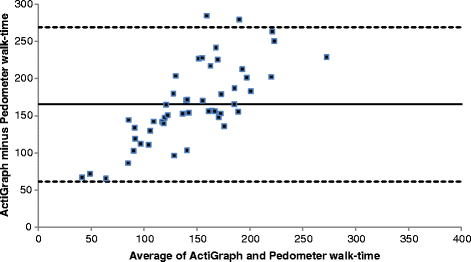Comparing accelerometer, pedometer and a questionnaire for measuring physical activity in bronchiectasis: a validity and feasibility study?
- PMID: 28088206
- PMCID: PMC5237513
- DOI: 10.1186/s12931-016-0497-2
Comparing accelerometer, pedometer and a questionnaire for measuring physical activity in bronchiectasis: a validity and feasibility study?
Abstract
Background: There are challenges for researchers and clinicians to select the most appropriate physical activity tool, and a balance between precision and feasibility is needed. Currently it is unclear which physical activity tool should be used to assess physical activity in Bronchiectasis. The aim of this research is to compare assessment methods (pedometer and IPAQ) to our criterion method (ActiGraph) for the measurement of physical activity dimensions in Bronchiectasis (BE), and to assess their feasibility and acceptability.
Methods: Patients in this analysis were enrolled in a cross-sectional study. The ActiGraph and pedometer were worn for seven consecutive days and the IPAQ was completed for the same period. Statistical analyses were performed using SPSS 20 (IBM). Descriptive statistics were used; the percentage agreement between ActiGraph and the other measures were calculated using limits of agreement. Feedback about the feasibility of the activity monitors and the IPAQ was obtained.
Results: There were 55 (22 male) data sets available. For step count there was no significant difference between the ActiGraph and Pedometer, however, total physical activity time (mins) as recorded by the ActiGraph was significantly higher than the pedometer (mean ± SD, 232 (75) vs. 63 (32)). Levels of agreement between the two devices was very good for step count (97% agreement); and variation in the levels of agreement were within accepted limits of ±2 standard deviations from the mean value. IPAQ reported more bouted- moderate - vigorous physical activity (MVPA) [mean, SD; 167(170) vs 6(9) mins/day], and significantly less sedentary time than ActiGraph [mean, SD; 362(115) vs 634(76) vmins/day]. There were low levels of agreement between the two tools (57% sedentary behaviour; 0% MVPA10+), with IPAQ under-reporting sedentary behaviour and over-reporting MVPA10+ compared to ActiGraph. The monitors were found to be feasible and acceptable by participants and researchers; while the IPAQ was accepta ble to use, most patients required assistance to complete it.
Conclusions: Accurate measurement of physical activity is feasible in BE and will be valuable for future trials of therapeutic interventions. ActiGraph or pedometer could be used to measure simple daily step counts, but ActiGraph was superior as it measured intensity of physical activity and was a more precise measure of time spent walking. The IPAQ does not appear to represent an accurate measure of physical activity in this population.
Trial registration: Clinical Trials Registration Number NCT01569009 : Physical Activity in Bronchiectasis.
Keywords: Actigraph; Bronchiectasis; Pedometer; Physical activity measurement; Step count.
Figures




Similar articles
-
Measuring physical activity during pregnancy.Int J Behav Nutr Phys Act. 2011 Mar 21;8:19. doi: 10.1186/1479-5868-8-19. Int J Behav Nutr Phys Act. 2011. PMID: 21418609 Free PMC article. Clinical Trial.
-
Validity of the International Physical Activity Questionnaire (IPAQ) for assessing moderate-to-vigorous physical activity and sedentary behaviour of older adults in the United Kingdom.BMC Med Res Methodol. 2018 Dec 22;18(1):176. doi: 10.1186/s12874-018-0642-3. BMC Med Res Methodol. 2018. PMID: 30577770 Free PMC article.
-
Assessing physical activity in people with posttraumatic stress disorder: feasibility and concurrent validity of the International Physical Activity Questionnaire--short form and actigraph accelerometers.BMC Res Notes. 2014 Aug 27;7:576. doi: 10.1186/1756-0500-7-576. BMC Res Notes. 2014. PMID: 25164278 Free PMC article.
-
Validity of objective methods for measuring sedentary behaviour in older adults: a systematic review.Int J Behav Nutr Phys Act. 2018 Nov 26;15(1):119. doi: 10.1186/s12966-018-0749-2. Int J Behav Nutr Phys Act. 2018. PMID: 30477509 Free PMC article.
-
Objectively Measured Physical Activity, Sedentary Behavior, and Metabolic Syndrome in Adults: Systematic Review of Observational Evidence.Metab Syndr Relat Disord. 2019 Feb;17(1):1-21. doi: 10.1089/met.2018.0032. Epub 2018 Sep 29. Metab Syndr Relat Disord. 2019. PMID: 30272527
Cited by
-
Digitally supported physical activity counselling for people with chronic back pain: a randomised controlled parallel feasibility study.BMC Prim Care. 2025 Feb 27;26(1):58. doi: 10.1186/s12875-025-02742-z. BMC Prim Care. 2025. PMID: 40016644 Free PMC article. Clinical Trial.
-
The Effect of Pulmonary Rehabilitation on the Physical Activity Level and General Clinical Status of Patients with Bronchiectasis.Turk Thorac J. 2019 Jan 1;20(1):30-35. doi: 10.5152/TurkThoracJ.2018.18093. Turk Thorac J. 2019. PMID: 30664424 Free PMC article.
-
On Placement, Location and Orientation of Wrist-Worn Tri-Axial Accelerometers during Free-Living Measurements.Sensors (Basel). 2019 May 6;19(9):2095. doi: 10.3390/s19092095. Sensors (Basel). 2019. PMID: 31064100 Free PMC article.
-
Free-Living Physical Activity Measured With a Wearable Device Is Associated With Larger Hippocampus Volume and Greater Functional Connectivity in Healthy Older Adults: An Observational, Cross-Sectional Study in Northern Portugal.Front Aging Neurosci. 2021 Nov 30;13:729060. doi: 10.3389/fnagi.2021.729060. eCollection 2021. Front Aging Neurosci. 2021. PMID: 34916921 Free PMC article.
-
A comparison of self-reported and device measured sedentary behaviour in adults: a systematic review and meta-analysis.Int J Behav Nutr Phys Act. 2020 Mar 4;17(1):31. doi: 10.1186/s12966-020-00938-3. Int J Behav Nutr Phys Act. 2020. PMID: 32131845 Free PMC article.
References
-
- Global recommendations on physical activity for health. World Health Organistaion; 2010. [http://apps.who.int/iris/bitstream/10665/44399/1/9789241599979_eng.pdf] accessed 17 Feb 2016. ISBN 978 92 4 159 997 9.
-
- Spruit MA, Singh SJ, Garvey C, ZuWallack R, Nici L, Rochester C, ATS/ERS Task Force on Pulmonary Rehabilitation et al. An official American Thoracic Society/European Respiratory Society statement: key concepts and advances in pulmonary rehabilitation. Am J Respir Crit Care Med. 2013;188:e13–64. doi: 10.1164/rccm.201309-1634ST. - DOI - PubMed
-
- Bradley JM, O’Neill B, Kent L, Hulzebos EHJ, Arets B, Hebestreit H, on behalf of the Exercise Working Group European CF Society Physical activity assessment in cystic fibrosis: a position statement endorsed by the European Cystic Fibrosis Society Board. J Cyst Fibros. 2015;14(6):e25–32. doi: 10.1016/j.jcf.2015.05.011. - DOI - PubMed
Publication types
MeSH terms
Associated data
LinkOut - more resources
Full Text Sources
Other Literature Sources
Medical

